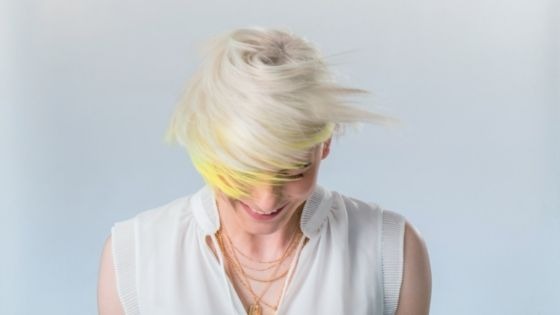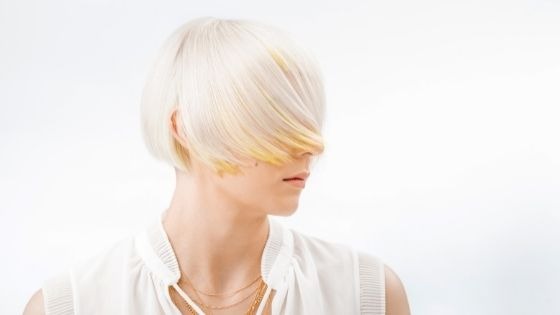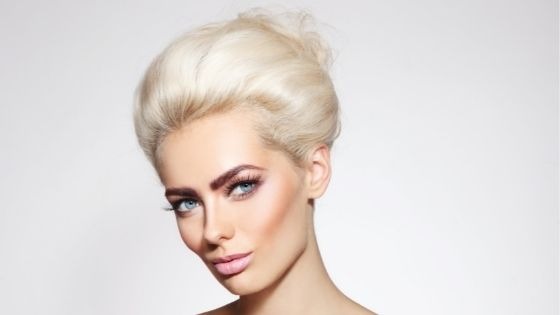How long do you leave bleach in your hair? Best hair tips

How long do you leave bleach in your hair? If you want to lighten your hair a few shades lighter, we recommend you leave the bleach in for up to 30 minutes.
If you want to go one or two levels lighter, then 15 minutes should be enough. Keep in mind that it will take longer to oxidize if you have black or dark brown hair.
For best results, make sure to coat the hair thoroughly with the product and cover it with plastic wrap before applying heat. The recommended time can increase by 5 minutes for every 30 minutes of heating.
Hair bleaching with a chemical is an intentional process. To get the best results from bleaching, you need to know how long to leave it in for depending on what color you want and what type of bleach or developer you are using.
Sometimes, this can vary from brand to brand, so make sure you research before starting your process.
- How to prepare a bleach mixture
- Tips for bleaching your hair at home
- What is the best way to get rid of the chlorine smell from my hair?
- Why does my hair feel dry after using shampoo and conditioner?
- How often should I wash my hair with shampoo and conditioner?
- Can I use a clarifying shampoo on color-treated or permed hair?
- Conclusion
How to prepare a bleach mixture
Bleach mixture: Mix half a tube of bleach with the one-quarter developer in a plastic bowl. For example, for virgin hair that has never been dyed before or lifted any color, use a 20 volume developer.
If your hair is more than 12 weeks old and dark brown, use 30 volume instead.
If you're looking to go lighter than platinum blonde, apply two tubes of bleach and one tube of 20 volume developer.
If you're looking for platinum blonde hair, apply three tubes of bleach to your hair with one-quarter or half a tube of 10 volume developer.
For the hair dye to penetrate your hair strands, you must ensure that your hair is damp.
Bleaching process application:
- Apply the bleach mixture to your hair. Start applying it up to 3 inches away from your roots and gradually move down towards the ends of your hair strands, section by section.
- Once you have covered every strand of hair on your head, wait for 30 minutes before using a comb to remove any remaining product.
- Rinse your hair thoroughly with warm water and apply shampoo twice to get rid of the harsh chemicals.
Depending on your hair type, leave bleach on for 30 minutes or up to 45 minutes if you have very coarse hair.
Keep in mind that the longer you leave it on, the more likely it is that your hair will develop a red tint. If your goal is to lift a few levels, you can do two bleaching sessions.
Tips for bleaching your hair at home

Achieving vibrant hair color is easier than you think, whether you want to lighten your hair or completely transform it with a bold, new shade, the first step in achieving the right blonde hue, so your bright locks pop.
So how do you get there? According to celebrity colorist Aura Friedman at Sally Hershberger salon in New York City, a fabulous blonde starts with at-home color.
"At home, hair color is so much easier to maintain and control," she says, "[your color] can't get too light or too dark." With that in mind, after you've chosen your desired color from the chart below, check out our step-by-step guide to dyeing your hair at home.
Here is a step-by-step guide to dying hair:
First, choose the suitable bleach for your hair's texture and shade.
Once you've dyed your hair blonde, you must choose which tone you want to use on your newly blonde locks. Whether it's icy white or pale yellow, Aura says it all depends on skin tone.
"I always say, look at your veins," she says, "(if you have) warm undertones, choose a golden blonde, or if [you have] cool undertones, go with an ashier color."
Choose the right shade of dye for your natural hair color. For example, if you have darker hair, pick a light brown dye.
Wash your hair with clarifying shampoo.
Aura says that to achieve the perfect blonde hue, the restorative power of a clarifying shampoo is essential.
"Clarifying shampoos are great at removing product buildup from hair," she explains, "[so] make sure you cleanse your hair well with a clarifying shampoo to remove any residue that may interfere with the color deposit."
Create a foil or plastic wrap barrier.
After washing your hair, section it into pieces and cover the strands with aluminum foil to keep dye off of your skin. If you're worried about dying your ears, Aura recommends using plastic wrap instead.
"If you color your hair with foils, make sure the foil is wrapped tightly against your skin to prevent any dye from seeping through," she says.
Cover your floor with newspaper.
Even if you're careful with application, some of the colors will likely end up on your bathroom floor or sink—and that's why Aura recommends covering your space with newspaper.
"You can cover entire surfaces—such as the floor, countertop, and sink—with old newspapers to avoid a mess," she says. Wear an old T-shirt or robe while coloring to keep yourself from getting stained.
Wear gloves when applying dye to your hair.
Wearing gloves is an easy way to protect your hands from getting dyed. Aura recommends using rubber gloves with a cotton lining, as they are the easiest to clean.
"When you're done coloring, just toss them into the trash!" she says.
Apply the dye evenly throughout your hair.
Aura warns that applying dye unevenly throughout your locks can result in a blotchy, uneven color.
"When applying dye evenly to hair that's longer than a few inches, you'll need to clip up the pieces, so they don't get dyed," she says. "Start from the bottom and work your way up."
Wait for the color to develop.
Once you've applied the dye, please wait for it to set. For light-colored hair, Aura recommends waiting about 15 minutes. For dark hair, wait at least 45 minutes before rinsing your hair clean in the shower.
"Most commercial color requires 30 minutes of development time—but if you have dark hair or want a lighter shade, you may need to leave it in longer," Aura says. Next, rinse hair thoroughly in the shower after rinsing the dye out.
Rinse your hair thoroughly with lukewarm water when you're done coloring.
Aura suggests shampooing your locks three times to get rid of all residue from the dye."If you rinse twice with cold water, it closes the hair cuticle layer of the hair shaft and forces the color to stay within your hair," she says.
Apply deep conditioning treatment.
Aura says that keeping your dyed strands healthy is essential for their vibrancy. "You can apply a deep conditioner on dry hair to restore the moisture after dying," she says. "Let it sit for 15 minutes, then rinse."
Leave the bleach in your hair for 25-45 minutes.
"If you have dark hair or want a lighter shade, you may need to leave it in longer," Aura says."Most commercial color requires 30 minutes of development time—but if you have dark hair or want a lighter shade, you may need to leave it in longer," Aura says.
"If your hair is light brown or darker in color, you'll need to pre-lighten the locks with bleach before applying the color," she explains. "Apply bleach and then follow with tone-on-tone color techniques."
If you have dark brown or black hair, you can tone your hair without bleaching it.
"I recommend using a palette knife instead of just squeezing the tube to get an even application," she says. "This looks much more natural."
If you have light brown or dirty blonde hair, apply the dye directly to your locks with a tint brush.
Aura suggests shampooing your locks three times to get rid of all residue from the dye.
"If you rinse twice with cold water, it closes the hair cuticle layer of the hair shaft and forces the color to stay within your hair," she says.
What is the best way to get rid of the chlorine smell from my hair?

Chlorine can leave hair feeling dry and brittle. This problem is made worse by the heat and humidity in much of the US.
Use a lightweight product.
Cover hair with a lightweight product like conditioner or apple cider vinegar to help seal moisture inside strands during cleansing.
Use distilled water
If your water is complex and full of minerals and chemicals, use distilled water for hair care. It does not have any bad stuff that can cause hair to be dry or coated incorrectly for the scalp.
Use a clarifying shampoo.
Use a clarifying shampoo twice a month to remove any buildup left behind by-products, soaps, and shampoos – even those labeled 'natural' or 'gentle.' Then, replace your shampoo with something more abrasive every two months to avoid excessive buildup.
Create a custom shampoo
Create a custom shampoo using natural ingredients for chlorine removals, such as ACV, baking soda, and hydrogen peroxide. Mix this solution with water in a spray bottle, apply it from roots to ends after cleansing, and then rinse well. Keep some ACV on hand as a store-bought alternative.
Mix a natural oil with your shampoo
A high concentration of chlorine can cause hair to take on an unattractive yellow or brassy tone, and over time this discoloration can become permanent.
To restore color and shine, mix a few drops of any oil like coconut oil with your shampoo. For example, Almond oil effectively fights chlorine and its effects and can help prevent further damage.
Cold rinse after shampooing and conditioning
Follow any of these treatments with a cold rinse after shampooing and conditioning to expedite the chlorine-removal process. Fill your sink with cold water and slowly pour it over your hair, leaving the water to pool around your scalp for several minutes before draining.
Use a mild acid solution.
If you have chlorine-resistant hair, rinse your hair with a mild acid solution. For example, use one tablespoon of vinegar mixed with two cups of water as an alternative to the oil treatment.
You may be interested in "Can you dye wet hair?"
Why does my hair feel dry after using shampoo and conditioner?
One straightforward answer is that the shampoo and conditioner strip away all of your natural oils instead of fortifying them. If you can, try looking for products that use more natural ingredients with moisturizing properties rather than stripping any moisture from your hair.
Allowing your hair to be stripped by chemicals will only contribute to dehydration, and it's not always an easy fix with just one product!
It's also possible that you're dehydrated from a poor diet or inefficient hydration habits. Another possibility is over-styling with heat or chemicals, damaging the cuticle on each strand and reducing the surface area available for water absorption.
Hair masks and conditioning treatments can only do so much when the cuticle is damaged and hydration has been depleted.
How often should I wash my hair with shampoo and conditioner?
For best results, shampoo your hair twice or three times a week. For better health in general, limit the chemicals you are using to clean yourself up.
Creating a healthy internal environment is the key to staying healthier longer. A healthy internal environment includes what goes on inside your skin, an essential barrier for chemical protection from the outside world.
One way to interfere with this process is by washing too much, leading to premature aging due to increased inflammation and quicker leaching of our natural oils that help keep our skin plump and youthful-looking.
I recommend using shampoo and conditioner every time you wash your hair.
Each strand of hair accumulates dirt, hairspray, sweat, and other toxins over a day without a cleanse from shampoo or conditioner.
This buildup gradually clogs pores on the scalp, contributing to horrible acne or cause cysts in some individuals.
Can I use a clarifying shampoo on color-treated or permed hair?
Yes, if you use a color-safe shampoo. A color-safe shampoo is a shampoo that will not remove the color from your hair while still effectively removing dirt and unwanted bacteria.
This type of shampoo can be necessary to avoid fading or stripping away essential healthy oils that keep the hair looking bright.
It's always best to consult your stylist before adding in any new product because they're most knowledgeable on what will work best for you. But generally speaking, it's safe to use a clarifying rinse now and again if needed.
If you do use one, though, make sure to follow up with appropriate moisturizing treatment, or else you'll risk stripping away much of the rich moisture which keeps our hair looking so healthy!
You may be interested in "How to get fluffy hair"
Conclusion
Bleaching your hair is one of the quickest ways to give it a new look. However, if you are looking for long-term results, this may not be the best option.
If you want to maintain your bleached hair color for as long as possible, follow these tips above!
Medically reviewed and approved by Nataniel Josue M D.
